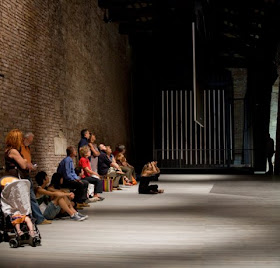EMILIO VEDOVA & RENZO PIANO
A
If I had chance to visit this exhibition at that time, I would like to listen 'Mareta nom faces plorar - Anon ' singing by Monserrat Figueras during being in Fondazione Vedova.
IMAGE
OF TIME ( BARRIER ) 1951
EMILIO VEDOVA
( 1919 - 2006 )
BRIEF
BIOGRAPHICAL NOTE
Born in Venice into a family of workers and artisans, from
the 1930s onwards Vedova began an intense activity as a self-taught artist,
drawing figures and buildings. In 1942, the young Vedova joined the
anti-Novecento movement known as “Corrente”.
An anti-Fascist, he worked for the Resistance from 1944 to 1945 and in 1946, he was one of the co-signers of the "Oltre Guernica" manifesto in Milan. In the same year in Venice he was one of the founders of the “Nuova Secessione Italiana” followed by the “Fronte Nuovo delle Arti”.
An anti-Fascist, he worked for the Resistance from 1944 to 1945 and in 1946, he was one of the co-signers of the "Oltre Guernica" manifesto in Milan. In the same year in Venice he was one of the founders of the “Nuova Secessione Italiana” followed by the “Fronte Nuovo delle Arti”.
In 1948 he
made his debut in the Venice Biennale, the first of many appearances in this
event: in 1952 an entire room was devoted to his work, in 1960 he was awarded
the Grand Prize for Painting and in 1997 the prestigious Golden Lion award for
Lifetime Achievement.
In the early 1950s he created his celebrated cycles of works: “Scontro di
situazioni” (Collision of Situations), “Ciclo della Protesta” (Protest Cycle),
“Cicli della Natura” (Cycles of Nature). In 1954, at the second São Paolo Art
Biennial he won a prize that would allow him to spend three months in Brazil,
where he encountered an extreme, hard reality that would leave its mark on him.
In 1961 he designed the sets and costumes for Luigi Nono’s “Intolleranza ‘60”
(Intolerance ’60); in 1984 he would work with the composer again on “Prometeo”.
From 1961
onwards he worked on his “Plurimi” creating an initial Venetian series followed
by works made from 1963 to 1964 in Berlin including the seven pieces forming
the “Absurdes Berliner Tagebuch ‘64” (Absurd Berlin Diary ’64) presented at the
1964 Kassel Documenta where he also showed in 1955, 1959 and 1982. From 1965 to
1967 he worked on “Spazio/Plurimo/Luce” (Space/Plurimo/Light) for the Montreal
EXPO.
He carried out intense teaching activities in various American universities
followed by the Sommerakademie in Salzburg and the Academy of Venice. His
artistic career was characterised by a constant desire to explore and innovate.
In the 1970s he created the “Plurimi Binari” in the “Lacerazione” (Laceration)
and “Carnevali” (So-called carnivals) cycles followed by the vast cycles of
“teleri” (big canvases) and his “Disks”, “Tondi”, “Oltre” (Beyond) and “…in
continuum…” (...in continuum...) works. He won numerous prestigious prizes and
awards. His last important solo exhibitions included the major retrospective
held at Castello di Rivoli in 1998 and, after his death in 2006, the sister
shows at Rome’s Galleria Nazionale d’Arte Moderna and the Berlinische Galerie
(Berlin).
You may visit
Emilio Vedova web page to read comprehensive biography to click below link.
http://www.fondazionevedova.org/en/emilio-vedova/biography/1919-1943

















%2B(Immagine%2Bdel%2Btempo%2B%5BSbarramento%5D)%2C%2B1951.png)






